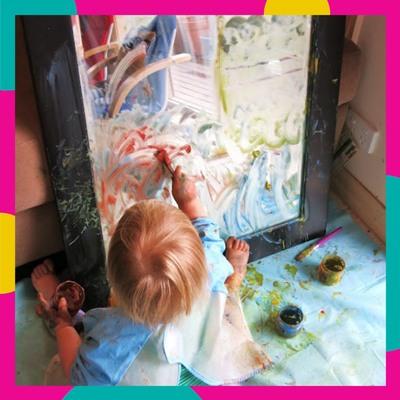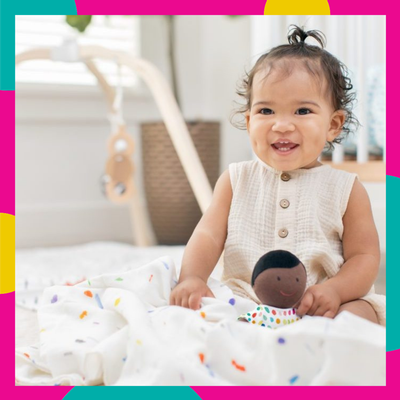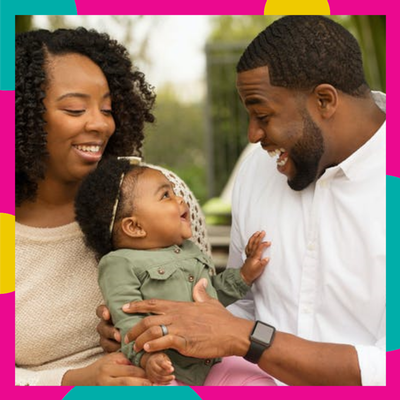Read, Baby, Read is a Free Library initiative focused on encouraging early literacy development among infants and young toddlers under two years old.
We work with 17 participating libraries across Philadelphia to reach caregivers of all ages, providing resources that support early literacy skills, language development, and purposeful play. You can find early literacy tips and resources on our Instagram page @read.baby.read!
In this bimonthly series, we bring you fun activity ideas with a theme based on the five early literacy practices from Every Child Ready To Read: Read, Sing, Write, Play, and Talk! So far, we’ve explored vehicles, animals, the body, water, food, shapes, feelings, nature, colors, numbers, and music!
This month is all about babies!
READ
Babies love looking at and reading about other babies, and there are a lot of board books about babies in the Free Library’s catalog. It’s easy to place holds online for free and schedule curbside pick-up at many libraries.
Global Babies by Maya Ajmera
Beautiful photographs and simple text allow you to explore babies from all different cultures and locations. This series also includes Global Baby Girls, Global Baby Boys, Global Baby Playtime, Global Baby Bedtimes, and American Babies.
Baby See, Baby Do by Robie Rogge
This board book about babies’ emotions includes a fold-out mirror so babies can mimic the expressions they see in the book.
Baby Peekaboo by Kate Merritt
This “Indestructible” book about babies playing is rip-proof, chew-proof, washable, and 100% non-toxic. Other “Indestructibles” about babies include Baby Faces, Baby Night-Night, Beach Baby, and Jingle Baby.
Baby Faces by Margaret Miller
The photographs in this book are perfect for babies who love looking at faces. Other books in this series are Baby Food, Baby Pets, Baby Talk, and Peekaboo Baby. For similar books with face photographs, check out the Baby Faces series from Roberta Grobel Intrater, which includes Smile!, Eat!, Splash!, and Peek-a-boo!
The Babies and Doggies Book by John Schindel
If there’s one thing babies love to look at as much as other babies, it’s animals! Also check out the companion book, The Babies and Kitties Book.
Where is Baby’s Belly Button? by Karen Katz
Most of Karen Katz’s colorful lift-the-flap books are all about babies! Other titles include Peek-a-Baby, What Does Baby Say?, How Does Baby Feel?, Where is Baby’s Yummy Tummy?, Baby Loves Spring, Baby Loves Summer, Baby Loves Fall, Baby Loves Winter, and Splish, Splash Baby.
You can find even more baby themed book recommendations on our community book list, “Board Books All About Babies.”
SING
If you want to sing about babies, start with lullabies – “Hush Little Baby” and “Rockabye Baby” are both classics! Other well known children’s songs and rhymes mention babies as well, such as the baby crying on the bus in “Wheels on The Bus” or the B for Baby in “Pat-a-Cake.” Jbrary, an excellent resource for finding rhymes, lap bounces, and tickles, has a whole Baby Storytime YouTube playlist, which includes songs like “Baby Baby Dumpling,” “Ride, Baby, Ride,” and “All The Little Babies.”
Singing “body parts” songs is another way for babies to learn about babies, since they’re learning about themselves. On our instagram, you can watch Natasha sing the body parts song “Where Oh Where Are Baby’s Fingers” while demonstrating how to incorporate gentle touch into the song. Jbrary also has a Body Parts playlist which includes songs like “Baby Put Your Pants On” and “These Are The Toes of My Baby.”
WRITE
Art is a great way to explore “writing,” and by making art a full body experience, you can encourage your child to learn more about babies by learning about themselves! Next time you paint, forego brushes or other painting utensils in favor of finger painting. For the littlest babies, try dipping their feet in paint and making footprint art. Be sure to use washable, taste-safe paint (try this edible paint recipe) so that you don’t have to worry about your baby painting themselves instead of the picture. You can also encourage this self-exploration by having your child paint or draw on a mirror. Mirror play helps babies learn about the most important baby – themselves! They may not yet understand they’re looking at their reflection, but they’ll still enjoy seeing another baby as they make art.
PLAY
Dolls are a classic toy for exploring “babies” with your baby, and playing with dolls encourages imagination and creativity. Pretend play (or “make-believe”) has lots of benefits in general, and when they’re playing make-believe with dolls, children are learning social skills, communication, and responsibility. Acting out real-life situations with their baby doll, such as feeding it or rocking it to sleep, helps them understand their own world. It also encourages the development of empathy. If you’re crafty, you can sew your own doll. But you don’t even have to have a doll to play make-believe, because any object can symbolically represent a baby. Grab a pillow and cradle it while singing “Rock-a-Bye Baby.” Symbolic thinking, which involves using an object to represent something else, is an important skill for children to develop, and using an object as a stand-in during pretend play (whether that’s a pillow as a doll or a block as a phone) is a good way to encourage these skills.
Another great option for play is playing with other babies! You can check out our calendar of events to find free Read, Baby, Read programs and playgroups in your area, or just show up at a Read, Baby, Read baby space or at a local park to meet other babies. At this age, most babies are not yet interacting with each other when they play, but parallel play, which means playing alongside each other, is an important first step toward developing future social skills.
TALK
Even though this month’s theme is babies, when talking to your baby we actually encourage you not to treat them like a baby! Have conversations with your baby even if they’re not talking yet. Ask your baby questions and give them time to respond even if they aren’t verbal (try counting out five seconds in your head to make sure you give them time to answer). This is called serve and return, and it teaches them how conversations work. Similarly, instead of speaking to your baby in “baby talk” (using nonsense words like googoo and gaga, or mimicking baby speech like “wawa” instead of “water”), use real words like you would with an adult. That’s how they learn words, so you want to make sure they learn real words! We still recommend using “parentese,” which involves changing the pitch and rhythm of your voice but using actual words instead of nonsense ones.
Read Baby Read’s team includes Early Childhood Specialists, Sarah Jacknis and Natasha Smith, and Program Coordinator, Kimberly Garrison. Read Baby, Read is made possible by a generous grant from the William Penn Foundation.
Have a question for Free Library staff? Please submit it to our Ask a Librarian page and receive a response within two business days.









